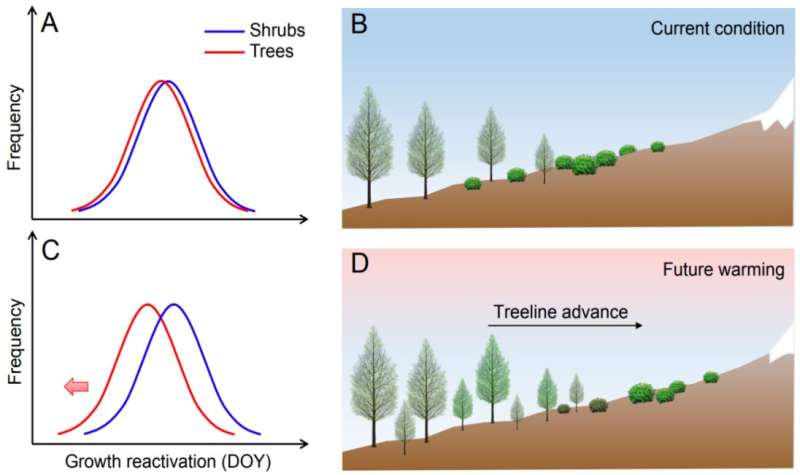This article has been reviewed according to Science X's editorial process and policies. Editors have highlighted the following attributes while ensuring the content's credibility:
fact-checked
trusted source
proofread
Why trees outcompete shrubs to shift upward

Climatic warming is altering the structure and function of alpine ecosystems, including shifts of vegetation boundaries. The upward shift of alpine treelines, the uppermost limit of tree growth forming the boundary between montane forest and alpine communities, is strongly modulated by shrub-tree interactions. But little is known on the responses of such coexisting life forms to a warmer climate.
Based on unique 8- and 10-year in situ observations of cambial phenology in sympatric trees and shrubs at two treelines on the southeastern Tibetan Plateau, researchers found an opposite pattern of cambial phenology between shrub and tree species in response to warming. Under a spring warming of +1°C, xylem resumption advances by 2-4 days in trees, but delays by 3-8 days in shrubs. The divergent phenological response to warming was due to shrubs being 3.2 times more sensitive than trees to chilling accumulation.
"Under the same amount of chilling, shrubs required more forcing accumulation than trees, leading to a delayed onset of cambial phenology. For trees, however, forcing was less dependent on chilling, thus resulting in an earlier cambial phenology under warmer spring," says Liang, who led the research team.
The researchers further performed a global meta-analysis combined with a process-based growth model to explore drivers of phenological growth shifts in response to warming, from 344 shrubs and 575 trees paired across 11 alpine treelines in the Northern Hemisphere. Based on the cambial phenological records derived from the growth model, they further infer divergent effects of spring temperature on cambial phenology between trees and shrubs in the treelines of the northern hemisphere.
Model outputs indicate trees show a higher sensitivity to spring warming than shrubs as expected. Shrubs are instead more influenced by chilling accumulation than trees. "Our meta-analysis confirmed the same mechanism across continental scales," Liang says.
Regardless of whether shrubs and trees at alpine treelines interact through facilitation or competition, climate warming has the potential to drive divergent shifts in their phenology. This would involve shortening the growing season for shrubs while extending it for trees. Consequently, the resulting phenological mismatch due to warming could confer a competitive advantage to trees over shrubs by increasing growth, carbon gain and improving resource availability, potentially promoting upward treeline shifts in cold mountainous regions.
The findings from this study, led by Professor Eryuan Liang (Institute of Tibetan Plateau Research, Chinese Academy of Sciences), were published as a research article in the journal National Science Review. The study also involved researchers from, CREAF, CSIC, Global Ecology Unit CREAF-CSIC-UAB, Instituto Pirenaico de Ecología (IPE-CSIC), Spain and Université du Québec à Chicoutimi, Canada.
More information: Xiaoxia Li et al, Warming-induced phenological mismatch between trees and shrubs explains high-elevation forest expansion, National Science Review (2023). DOI: 10.1093/nsr/nwad182
Provided by Science China Press




















